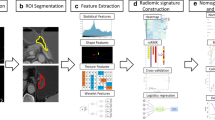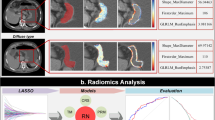Abstract
Background
Precise preoperative prediction of lymph node metastasis (LNM) is crucial for optimal diagnosis and treatment in patients with gastric cancer (GC), in which existing imaging methods have certain limitations. We hypothesized that PET primary lesion-based radiomics signature could provide incremental value to conventional metabolic parameters and traditional risk indicators in predicting LNM in patients with GC.
Methods
This retrospective study was performed in 127 patients with GC who underwent preoperative PET/CT. Basic clinical data and PET conventional metabolic parameters were collected. Radiomics signature was constructed by the least absolute shrinkage and selection operator algorithm (LASSO) logistic regression. Based on the postoperative histological results, the patients were divided into LNM group and non-lymph node metastasis (NLNM) group. Receiver-operating characteristic (ROC) was used to evaluate the discriminatory ability of Radiomics score (Rad-score) for predicting LNM and determine whether adding Rad-score to PET conventional metabolic parameters and traditional risk factors could improve the predictive value in LNM. The Integrated discrimination improvement (IDI) and net reclassification improvement (NRI) were calculated to further confirm the incremental value of Rad-score for predicting LNM in GC.
Results
The LNM group had higher Rad-score than NLNM group [(0.35 (−0.13–0.85) vs. −0.61 (−1.92–0.18), P < 0 .001)]. After adjusted for gender, age, BMI, and FBG, multivariable logistic regression analysis illustrated that Rad-score (OR: 6.38, 95% CI: 2.73–14.91, P < 0.0001) was independent risk factors for LNM in GC. Adding PET conventional parameters to traditional risk factors increased the predictive value of LNM in GC (AUC 0.751 vs 0.651, P = 0.02). Additional inclusion of Rad-score to conventional metabolic parameters and traditional risk indicators significantly improved the AUC (0.882 vs 0.751; P = 0.006). Bootstrap resampling (times = 500) was used for internal verification, 95% confidence interval (CI) was 0.802–0.948, with the sensitivity equaled to 89.5%, and positive predictive value (PPV) was 93.5%. When Rad-score was added to conventional metabolic parameters and traditional risk indicators, net reclassification improvement (NRI) was 0.293 (P = 0.0040) and integrated discrimination improvement (IDI) was 0.293 (P = 0.0045).
Conclusion
In GC patients, PET Radiomics signature of the primary lesion-based was significantly associated with LNM and could improve the prediction of LNM above PET conventional metabolic parameters and traditional risk factors, which could provide incremental value for individual diagnosis and treatment of GC.



Similar content being viewed by others
Data availability
The data that support the findings of this study are available on separate scientific request (Contact Prof. Yuetao Wang, Address: Department of Nuclear Medicine, The Third Affiliated Hospital of Soochow University, No.185, Juqian Street, Changzhou, Jiangsu Province, China, e-mail: yuetao-w@163.com), but restrictions apply to the availability of these data, which were used under license for the current study and, hence, are not publicly available.
References
Sung H, Ferlay J, Siegel R, L, et al, Global Cancer Statistics 2020: GLOBOCAN Estimates of Incidence and Mortality Worldwide for 36 Cancers in 185 Countries, CA Cancer J Clin, 2021, 71(3), 209-249.
Wang F, H.Zhang X, T.Li Y, F, et al, The Chinese Society of Clinical Oncology (CSCO): Clinical guidelines for the diagnosis and treatment of gastric cancer, 2021, Cancer Commun (Lond), 2021, 41(8), 747-795.
Kutlu O, C, Watchell M, Dissanaike S, Metastatic lymph node ratio successfully predicts prognosis in western gastric cancer patients, Surg Oncol, 2015, 24(2), 84-8.
Kim D, H.Choi M, G.Noh J H, et al, Clinical significance of skip lymph node metastasis in gastric cancer patients, Eur J Surg Oncol, 2015, 41(3), 339-45.
Huang C, Hu C, Zhu J, et al, Establishment of Decision Rules and Risk Assessment Model for Preoperative Prediction of Lymph Node Metastasis in Gastric Cancer, Front Oncol, 2020, 10, 1638.
Wang K, Jiang X, Ren Y, et al, The significance of preoperative serum carcinoembryonic antigen levels in the prediction of lymph node metastasis and prognosis in locally advanced gastric cancer: a retrospective analysis, BMC Gastroenterol, 2020, 20(1), 100.
Ajani J, A.D'Amico T, A.Bentrem D, J, et al,. 2022. NCCN Clinical Practice Guidelines in Oncology. J Natl Compr Canc Netw. 20(2), 167–192.
Kudou M, Kosuga T, Kubota T, et al, Value of Preoperative PET-CT in the Prediction of Pathological Stage of Gastric Cancer, Ann Surg Oncol, 2018, 25(6), 1633-1639.
Kwee R, M,Kwee T, C, Imaging in assessing lymph node status in gastric cancer, Gastric Cancer, 2009, 12(1), 6-22.
Song B, I, Nomogram using F-18 fluorodeoxyglucose positron emission tomography/computed tomography for preoperative prediction of lymph node metastasis in gastric cancer, World J Gastrointest Oncol, 2020, 12(4), 447-456.
Arslan E, Aksoy T, Gündoğan C, et al, Metabolic Characteristics and Diagnostic Contribution of (18)F-FDG PET/CT in Gastric Carcinomas, Mol Imaging Radionucl Ther, 2020, 29(1), 25-32.
Xue X, Q, Wang B, Yu W, J, et al, Relationship between total lesion glycolysis of primary lesions based on 18F-FDG PET/CT and lymph node metastasis in gastric adenocarcinoma: a cross-sectional preliminary study, Nucl Med Commun, 2022, 43(1), 114-121.
Sollini M, Antunovic L, Chiti A, et al, Towards clinical application of image mining: a systematic review on artificial intelligence and radiomics, Eur J Nucl Med Mol Imaging, 2019, 46(13), 2656-2672.
Nioche C, Orlhac F, Boughdad S, et al, LIFEx: A Freeware for Radiomic Feature Calculation in Multimodality Imaging to Accelerate Advances in the Characterization of Tumor Heterogeneity, Cancer Res, 2018, 78(16), 4786-4789.
Liu G, Hu Y, Cheng X, et al, Volumetric parameters on (18)F-FDG PET/CT predict the survival of patients with gastric cancer associated with their expression status of c-MET, BMC Cancer, 2019, 19(1), 790.
Park J. S, Lee N, Beom S. H, et al, The prognostic value of volume-based parameters using (18)F-FDG PET/CT in gastric cancer according to HER2 status, Gastric Cancer, 2018, 21(2), 213-224.
Boellaard R, Delgado-Bolton R, Oyen W. J, et al, FDG PET/CT: EANM procedure guidelines for tumour imaging: version 2.0, Eur J Nucl Med Mol Imaging, 2015, 42(2), 328-54.
Hatt M, Majdoub M, Vallières M, et al, 18F-FDG PET uptake characterization through texture analysis: investigating the complementary nature of heterogeneity and functional tumor volume in a multi-cancer site patient cohort, J Nucl Med, 2015, 56(1), 38-44.
Collins G. S, Reitsma J. B, Altman D. G, et al, Transparent reporting of a multivariable prediction model for individual prognosis or diagnosis (TRIPOD): the TRIPOD statement, Bmj, 2015, 350, g7594.
Wang J, Zhong L, Zhou X, et al, Value of multiphase contrast-enhanced CT with three-dimensional reconstruction in detecting depth of infiltration, lymph node metastasis, and extramural vascular invasion of gastric cancer, J Gastrointest Oncol, 2021, 12(4), 1351-1362,
Wang Z, L, Zhang X, P, Tang L, et al, Lymph nodes metastasis of gastric cancer: Measurement with multidetector CT oblique multiplanar reformation-correlation with histopathologic results, Medicine (Baltimore), 2016, 95(39), e5042.
Sun Z, Li J, Wang T, et al, Predicting perigastric lymph node metastasis in gastric cancer with CT perfusion imaging: A prospective analysis, Eur J Radiol, 2020, 122, 108753.
Wang Y, Liu W, Yu Y, et al, CT radiomics nomogram for the preoperative prediction of lymph node metastasis in gastric cancer, Eur Radiol, 2020, 30(2), 976-986.
Liu S, Shi H, Ji C, et al, Preoperative CT texture analysis of gastric cancer: correlations with postoperative TNM staging, Clin Radiol, 2018, 73(8), 756.e1-756.e9.
Feng Q, X, Liu C, Qi L, et al, An Intelligent Clinical Decision Support System for Preoperative Prediction of Lymph Node Metastasis in Gastric Cancer, J Am Coll Radiol, 2019, 16(7), 952-960.
An Y, S, Kang D, K, Jung Y, et al, Volume-based metabolic parameter of breast cancer on preoperative 18F-FDG PET/CT could predict axillary lymph node metastasis, Medicine (Baltimore), 2017, 96(45), e8557.
Kim S, J,Pak K,Chang S, Determination of regional lymph node status using (18)F-FDG PET/CT parameters in oesophageal cancer patients: comparison of SUV, volumetric parameters and intratumoral heterogeneity, Br J Radiol, 2016, 89(1058), 20150673.
Kaida H, Toh U, Hayakawa M, et al, The relationship between 18F-FDG metabolic volumetric parameters and clinicopathological factors of breast cancer, Nucl Med Commun, 2013, 34(6), 562-70.
Nie P, Yang G, Wang N, et al, Additional value of metabolic parameters to PET/CT-based radiomics nomogram in predicting lymphovascular invasion and outcome in lung adenocarcinoma, Eur J Nucl Med Mol Imaging, 2021, 48(1), 217-230.
Chen W, Wang S, Dong D, et al, Evaluation of Lymph Node Metastasis in Advanced Gastric Cancer Using Magnetic Resonance Imaging-Based Radiomics, Front Oncol, 2019, 9, 1265.
Liu Q, Li J, Xin B, et al, (18)F-FDG PET/CT Radiomics for Preoperative Prediction of Lymph Node Metastases and Nodal Staging in Gastric Cancer, Front Oncol, 2021, 11, 723345.
Liang J, Liang H, Deng J, et al, [Clinical study on lymph node metastasis regularity in 1456 patients with gastric cancer], Zhonghua Wei Chang Wai Ke Za Zhi, 2018, 21(10), 1154-1160.
Funding
None.
Author information
Authors and Affiliations
Contributions
All authors were involved in drafting the article or revising it critically for important intellectual content, and all authors approved the final version to be published. Prof. YW had full access to all of the data and takes responsibility for the accuracy of the data analysis. Study conception and design: XX; Acquisition of data: WY; Analysis and interpretation of data: XS and YW.
Corresponding author
Ethics declarations
Conflict of interest
The authors declare that they have no competing interests.
Ethical approval
This study was approved by the institutional ethics committee of the Third Affiliated Hospital of Soochow University and conducted according to the Declaration of Helsinki. Written informed consent was obtained prior to study inclusion.
Consent for publication
Not applicable.
Additional information
Publisher's Note
Springer Nature remains neutral with regard to jurisdictional claims in published maps and institutional affiliations.
Rights and permissions
Springer Nature or its licensor (e.g. a society or other partner) holds exclusive rights to this article under a publishing agreement with the author(s) or other rightsholder(s); author self-archiving of the accepted manuscript version of this article is solely governed by the terms of such publishing agreement and applicable law.
About this article
Cite this article
Xue, Xq., Yu, WJ., Shao, XL. et al. Incremental value of PET primary lesion-based radiomics signature to conventional metabolic parameters and traditional risk factors for preoperative prediction of lymph node metastases in gastric cancer. Abdom Radiol 48, 510–518 (2023). https://doi.org/10.1007/s00261-022-03738-4
Received:
Revised:
Accepted:
Published:
Issue Date:
DOI: https://doi.org/10.1007/s00261-022-03738-4




